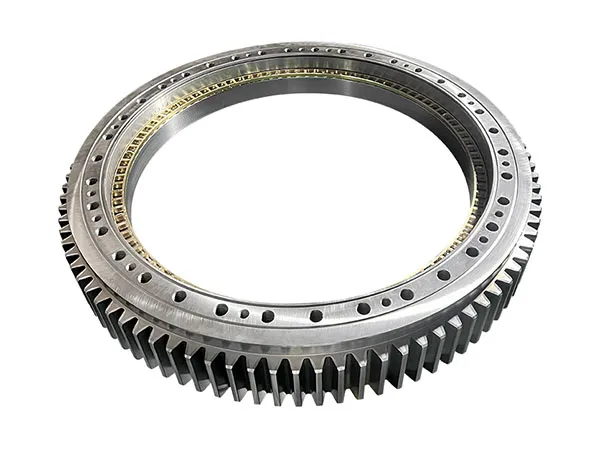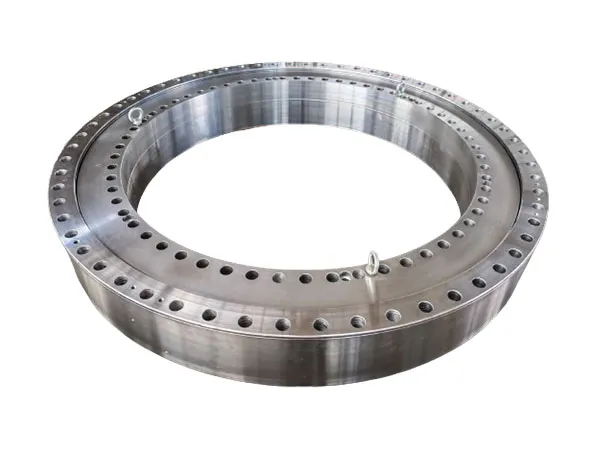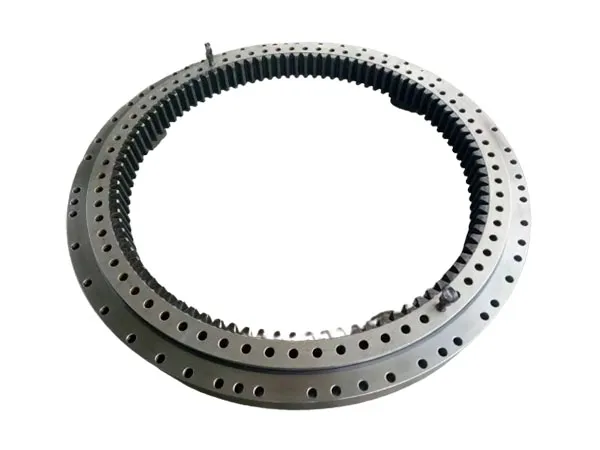- +86 13837949030 +86 15890619536
- info@lymcbearings.com export@lymcbearings.com
- Luoxin Industrial Cluster, Luoyang City,Henan Province,China
Time:2025-06-06 03:02:43 Source:LYMC Slewing Bearing
Slewing bearings withstand radial loads through a combination of their internal geometry, the distribution of force across multiple rolling elements, and the structural rigidity of their rings.

First, let's be clear on the force we're talking about. In the context of a slewing bearing (like the one on a crane), a radial load is a force that pushes or pulls on the bearing from the side, perpendicular to the central axis of rotation.
Example: The force of the wind pushing against the side of a long crane boom.
Contrast with other loads:
Axial (or Thrust) Load: A force acting parallel to the axis of rotation (e.g., the weight of the crane's cabin and boom pushing straight down).
Moment (or Tilting) Load: A force that tries to tip or overturn the bearing (e.g., the weight of a heavy object lifted at the end of the crane boom).
Slewing bearings are remarkable because they are designed to handle all three types of loads simultaneously. Their ability to handle radial loads is a direct result of this multi-load design.
The "magic" happens inside the bearing, specifically in the way the rolling elements (balls or rollers) make contact with the inner and outer rings (the raceways).
A. For Four-Point Contact Ball Bearings (The Most Common Type)
This is the classic design. Imagine cutting a slewing bearing in half. You would see that the groove (raceway) the balls run in is not a simple semi-circle. It's shaped like a gothic arch or two shallow V's.
How it Works: When a radial load pushes the inner ring sideways, the balls are forced up the angled raceways of both the inner and outer rings.
The Contact Angle: The force is transmitted through the balls at an angle (the "contact angle"). This angle means that a single radial force is resolved into two components: one that is axial and one that is radial.
The Key Takeaway: Because the ball contacts the raceway on an angle, it can resist forces from both the side (radial) and top/bottom (axial) simultaneously. A single ball acts like two separate bearings pushed against each other at an angle, all in one compact design.
B. For Crossed Roller Bearings
This design is even more explicit in how it handles loads from different directions.
How it Works: Cylindrical rollers are arranged in a crisscross pattern, with each roller oriented at 90 degrees to the one next to it.
Separation of Duty:
One set of rollers, oriented vertically, primarily handles axial (downward) loads.
The other set of rollers, oriented horizontally, is perfectly positioned to handle the radial (sideways) loads.
The Key Takeaway: This design physically separates the task of withstanding different loads among different sets of rollers, making it extremely rigid and precise, especially against radial forces.

A single ball or roller doesn't take the entire load. When a radial force is applied, it is distributed across a large number of rolling elements in the "load zone."
Imagine pushing on the side of a barrel. The force isn't concentrated on one tiny point; it's spread across an arc of staves on that side.
Similarly, the radial load on a slewing bearing is shared by all the balls or rollers in the arc on the side where the force is applied. This distribution prevents any single element from being overloaded and ensures smooth rotation even under immense side pressure.
The rolling elements and raceways can only do their job if the rings that hold them are incredibly strong and stiff.
Forged Steel: Slewing bearing rings are typically made from high-strength, surface-hardened forged steel.
Maintaining Geometry: This immense rigidity ensures that the rings do not deform or flex under load. If the rings were to bend, the precise contact angles of the raceways would be lost, and the bearing would fail quickly.
Mounting is Crucial: This is also why the mounting procedure for a slewing bearing is so critical. The bearing must be bolted to a perfectly flat and rigid foundation. If the foundation flexes, it will distort the bearing ring and cause premature failure.
Analogy: The V-Shaped Wedge
Think of trying to stop a heavy sliding block with a V-shaped wedge.
If you use a flat block (like a traditional radial bearing), it's good at stopping forward motion but can easily be pushed aside.
If you use a V-shaped wedge (like the raceway in a slewing bearing), its angled sides resist both forward motion and sideways motion. The sideways force just pushes the wedge more firmly into place.
The angled raceways in a slewing bearing work on the same principle, using angles to cleverly turn a radial force into a manageable compressive force on the rolling elements.

In short, slewing bearings withstand radial loads through a masterful combination of:
Angled Raceways: The special geometry (like a four-point contact or crossed rollers) resolves the radial force into manageable components on the rolling elements.
Load Distribution: The force is shared across a wide arc of multiple balls or rollers, preventing overload at any single point.
Inherent Structural Rigidity: The massive, stiff rings maintain the precise internal geometry required for the system to work under extreme pressure.
Preload: Many bearings are assembled with a slight internal preload, which eliminates any sloppiness and ensures the rolling elements are always in firm contact with the raceways, ready to resist radial loads instantly.